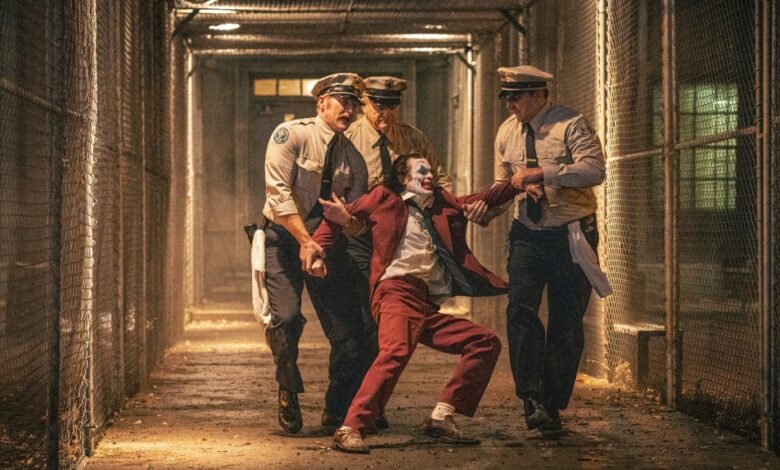Joker: Foli a Deux review: A study in fantasy and obsession

After 2019’s “Joker” nabbed $1 billion box office dollars and a Best Actor Oscar for Joaquin Phoenix, a sequel was certain.
What form that sequel would take, however, was less certain.
In the risk averse entertainment landscape that is 2024 Hollywood, one would have expected a continuation of Joker’s reign as Gotham City’s most unhinged agent of chaos.
Well, no one will accuse director Todd Phillips and stars Joaquin Phoenix and Lady Gaga of being risk averse.
For better and for worse, “Joker: Folie à Deux” mixes romance and show tunes with law and order in what may be the bleakest jukebox musical ever made.
Question is: Is the risk worth the reward?
 This image released by Warner Bros. Pictures shows Joaquin Phoenix, foreground centre, and Brendan Gleeson, background centre, in a scene from “Joker: Folie à Deux.” (Niko Tavernise/Warner Bros. Pictures via AP)
This image released by Warner Bros. Pictures shows Joaquin Phoenix, foreground centre, and Brendan Gleeson, background centre, in a scene from “Joker: Folie à Deux.” (Niko Tavernise/Warner Bros. Pictures via AP)
From its animated 1950’s Looney Tunes style opening — a recap of the Joker’s killing of talk show host Murray Franklin (Robert de Niro) on live television — to its starkly staged musical numbers, it is a study in fantasy, the ordinariness of evil, and obsession that is sure to deeply divide audiences.
Phoenix stars as failed-comedian-turned-murderer Arthur Fleck. Incarcerated at Arkham State Hospital, he awaits trial for his crimes as Joker, when a chance encounter with Harleen “Lee” Quinzel (Lady Gaga) gives him a chance at finding true love as they woo one another with show tunes.
Phillips, working from a script he co-wrote with Scott Silver, wedges big ideas about the commodification of Joker as an entertainment celebrity — underlined by the use of the tune “That’s Entertainment” from the 1953 musical “The Band Wagon” — obsession/delusion and betrayal, into a film that blurs the line between reality and fantasy.
It’s ambitious, like Bob Fosse’s “All That Jazz” filtered through a funhouse mirror, but it’s also frustrating. Frustrating in the sheer volume of underwhelming musical numbers that feel jammed into the story, in its laboured courtroom drama and its underuse of Lady Gaga.
The musical numbers are mostly fantasy sequences and vary from full production numbers to intimate renderings of love songs. Each tune acts as a substitute for dialogue or an inner, emotional soundtrack that only the characters can hear. When it works, it’s a neat trick, but often the songs feel a bit too on-the-nose, as in Gaga’s performance of “(They Long to Be) Close to You,” sung during a prison visit as a thick plate of Plexiglas separates them.
The musical numbers are plentiful, performed with a lack of polish — because, the press notes say, neither Arthur nor Harleen are professional singers — that works for the authenticity of the characters, but is less interesting for the audience. It’s a device and, if used sparingly, it could have been a nifty one. As it is, however, when Arthur says, “I don’t wanna sing anymore,” near the end of the film, it seems like the best decision he’s made all along.
 This image released by Warner Bros. Pictures shows Joaquin Phoenix, left, and Lady Gaga in a scene from “Joker: Folie à Deux.” (Niko Tavernise/Warner Bros. Pictures via AP)
This image released by Warner Bros. Pictures shows Joaquin Phoenix, left, and Lady Gaga in a scene from “Joker: Folie à Deux.” (Niko Tavernise/Warner Bros. Pictures via AP)
As Arthur/Joker, Phoenix transforms himself physically; his slight, bony frame a testimonial to the years of abuse Arthur suffered at the hands of his mother. However, when he puts on the Joker outfit — the garishly coloured suits, shirts and makeup — his shoulders square up and he becomes a different person. It’s an interesting shift and Phoenix embodies it, creating two characters from one source.
Unfortunately, Lady Gaga is given less to do.
The film’s broken heart is Lee’s attraction to Joker. In the film’s first hour, she’s a compelling character, a kind of Mansonesque follower whose curiosity with Arthur/Joker as a rebellious folk hero blossoms into the shared delusional disorder of the title (Folie à Deux). It’s a shame then, when she fades from view during the bulk of the courtroom scenes, discarded in favour of a focus on Arthur’s antics.
“Joker: Folie à Deux” is a comic book movie that breaks free of the shackles of the comic book genre, but in doing so blunts the power and the danger of its title character.




